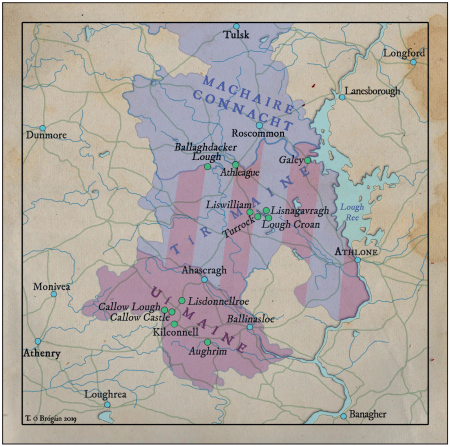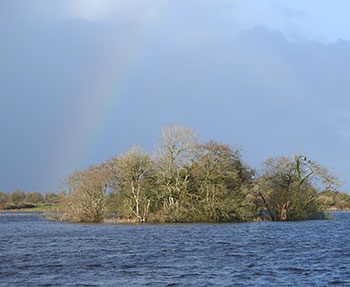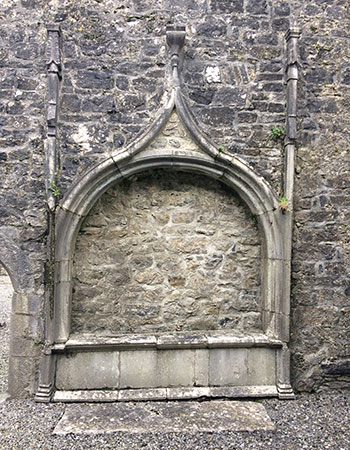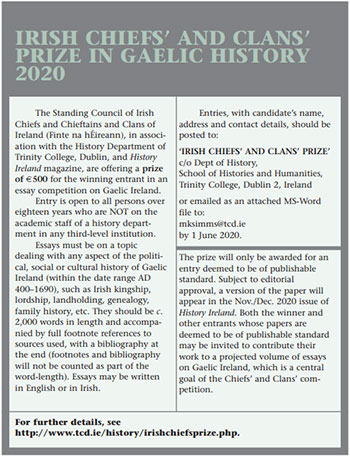William Buide O’Kelly and the late medieval renaissance of the Uí Maine lordship
Published in Features, Issue 6 (November/December 2019), Volume 27By Daniel Curley
The late fourteenth-century composition Leabhar Ua Maine serves as a high-water mark in the fortunes of the O’Kelly kings of Uí Maine. It is a carefully chosen expression of the wealth and authority that these eastern Connacht lords commanded. This ‘great book’ was commissioned by Muircertach O’Kelly, bishop of Clonfert and archbishop of Tuam, a member of the senior O’Kelly line. Muircertach’s motivation is likely to have been influenced by the actions and career of his sometime lord and great-uncle William Buide O’Kelly, king of Uí Maine (r. c. 1349–81), the subject of this article.

Change and reorganisation
The later medieval O’Kelly lordship of Uí Maine was subject to much change and reorganisation, particularly in the twelfth and into the thirteenth century. A decades-long power struggle erupted in the twelfth century between the O’Conor kings of Connacht and the O’Kellys owing to a concerted effort on the part of the O’Conors to curb the power of their southern neighbours, with significant conflicts in both 1135 and 1180. The O’Conors adopted a policy of positioning branches of their own wider kin group as a means of securing power in eastern Connacht. A dynastic family of the Síl Muiredaig, the Clann Uadach, and their chiefs, the O’Fallons, were transplanted from their homeland in Tír Briúin na Sinna (between Elphin and Jamestown, Co. Roscommon) into the O’Kelly ancestral trícha cét of Tír Maine at some point in the early twelfth century, a tactic designed to limit O’Kelly power in the area.
This manoeuvre was successful, resulting in the relocation of the senior O’Kelly line from Tír Maine into Uí Maine. By the mid-thirteenth century, however, the O’Kellys, who had established their cenn áiteanna at Aughrim and Kilconnell, Co. Galway, were deprived of their authority in the latter region, which was wrested from their control through Anglo-Norman grants from around 1253. From this point through to the middle of the fourteenth century a much-changed Tír Maine was returned to by the senior O’Kelly line, precariously positioned between the O’Conor dynasts to their north in their ancestral homelands of Machaire Connacht and within Tír Maine itself, as well as Anglo-Norman interests both to their west and through the trícha cét. William Buide O’Kelly entered this political environment in 1340.
William Buide O’Kelly
We first encounter William as part of a power struggle for the Uí Maine kingship. Tadhg Óg, newly elected king of Uí Maine and William’s first cousin once removed, identified William as his rival; in 1340 he attempted to remove this obstacle, an action which resulted in his own demise. Annála Connacht records the internecine fighting, while the record of the incident in the Annals of the Four Masters describes Tadhg as having banished William from Tír Maine. According to Leabhar Ua Maine, Tadhg’s reign as king lasted a total of three days.
William did not directly succeed Tadhg as king of Uí Maine, however. Tadhg’s successor was Diarmaid O’Kelly, who reigned until c. 1349. It is calculated that William ascended to the kingship in that year, and it is with his reign that we see the power of Uí Maine at its zenith in the medieval period. This increase in power manifested itself in a number of forms, as we shall see.
Praise-poem
Our earliest account of William as king of Uí Maine is a praise-poem, Táth aoinfhir ar iath Maineach, written c. 1349 to celebrate his ascension to the kingship. Recently translated, it provides vital insights into his early career. Stanzas 64–72 recount a series of cattle-raids led by William to Athenry, Maonmaigh (barony of Loughrea) and Duniry, Co. Galway, and to Limerick and east Munster. Although these raids are included in the poem in order to highlight his martial prowess, the fact that the locations are identified would suggest that they were not just a literary flourish.
The poem possesses other noteworthy entries, not least descriptions of William’s feasting hall and residence:
‘19 Many are the players of brandubh [a medieval board game] playing around its doorposts and its blackbird-thronged wall of shields, the hazel-white hostel whose house-post is not crooked …
21 Around the fort of the descendant of Cairbre [a legendary ancestral figure] which is surrounded by sea-water …’
A speculative identification can be proposed for William’s feasting hall and residence. The feasting hall may correspond with a townland name, Lisnagavragh—Lios na gCabhrach (‘the fort of the embossed shields’)—and its substantial ringfort, directly to the north of Lough Croan turlough, Co. Roscommon. Lough Croan has been demonstrated to have been a place of significance to the Uí Maine and O’Kellys throughout the medieval period, increasing the possibility that this site may have been frequented by William.
Crannogs and ringforts

Above: A substantial crannog in the centre of Callow Lough, Co. Galway, a possible focal point of the Callow cenn áit.
The description of William’s fort as being surrounded by ‘sea-water’ may be a literary embellishment used in describing a crannog or island site, a number of which are located in Lough Croan and present evidence for later medieval activity. There is a growing body of research in support of the construction and use of crannogs, feasting halls of wattle-and-daub form and ringforts by later medieval Gaelic élites, for both practical societal reasons and as a way of reinforcing lordly power through developing ties with legacy and an ancient heroic past.
Finally for Lough Croan, the townland of Liswilliam—Lios Uilliam (‘William’s fort’)—derives its name from the substantial ringfort located there. Liswilliam lies to the west of Lough Croan and the townland of Turrock, the location of a sixteenth-century O’Kelly castle. Liswilliam could refer to one of only two O’Kelly kings, William Buide or William the king of Iar Uí Maine (1472–6) and later of all Uí Maine (1476–87). Of these two, it is most likely to refer to William Buide, who perhaps constructed or modified the site.
The first annalistic reference to William as king is in 1351, with his hosting, along with his son Maolshechlainn, of a gathering known as ‘Invitation Christmas’. This is described as a general invitation to all the poetic classes in Ireland, and the event is immortalised in the poem Filidh Éreann Go Haointeach. The location of this festivity is recorded as Fionngháille and this name has caused confusion, with some suggesting it to be Galey, Co. Roscommon, and others suggesting it to be near Gallagh, Co. Galway. The place-name evidence favours Galey rather than Gallagh.
Kilconnell Friary

Above: A fourteenth-century tomb niche at Kilconnell Friary, Co. Galway, the possible resting place of William Buide O’Kelly.
In 1353 William founded Kilconnell Friary, Co. Galway. Built near the earlier ecclesiastical foundation of St Conall, a sixth-century follower of Patrick, it was well served by the overland route of the Slighe Mhór. Kilconnell Friary was heavily patronised by the O’Kellys in the following centuries, but its establishment and benefaction by William is significant in that it shows him to be operating in a region that had been granted 100 years previously to Anglo-Norman lords at O’Kelly expense.
In this year also, William is recorded as constructing the castle or ‘bawn’ of Callow. Callow, Co. Galway, is 3km north of Kilconnell and contains the remains of a castle, an enclosure and a crannog on Callow Lough. William’s establishment of Kilconnell Friary, coupled with his activities at Callow, plainly represent his creation or restoration of a cenn áit in this area.
There is evidence that this area was a focal point for O’Kelly settlement prior to William. Consulting the place-name evidence, Lisdonnellroe—Lios Dónaill Rua (‘Red Dónal’s fort’)—directly north of Callow may refer to a thirteenth-century king of Uí Maine, Domnall Mhór O’Kelly, who ruled until his death in 1224 at nearby Aughrim. Domnall’s son and successor, Conor, is also noteworthy for having Kilconnell associations, and a bivallate ringfort reflects the lios of the townland name.
Other sources corroborate William’s restoration of a cenn áit at Callow. Nósa Ua Maine, a fourteenth-century composition, possibly commissioned by William, is part of a literary genre that concerns the documentation of the rights and privileges of a ruler in later medieval Ireland. Paragraph 42 states: ‘The district of Caladh [Callow] holds the stewardship of both petty rent and great exaction’. This confirms where all rents and taxes to O’Kelly are collected, indicating that Callow was a key administrative base within the lordship.
Service kindreds
Nósa Ua Maine is also helpful in identifying service kindreds who held hereditary roles attached to the O’Kellys, as it records offices accorded to minor families in the lordship. Three hereditary offices can be identified near Callow:
‘The Muintir Dhubagáin are responsible for the safe-keeping of his rights and his traditional lore …
The Uí Longorgáin from Baile na Banabadh are his harpers.
His horn-players are from Lis na Cornairead, that is, the Uí Shideacháin.’
‘Muintir Dhubagáin’ refers to the O’Dugans, hereditary poets to the O’Kellys. The late fourteenth- to early fifteenth-century Triallam timcheall na Fodla was composed by Seán Mór O’Dugan, and Seán was ollamh seanchaí to the Uí Maine during his lifetime. It has been suggested that William’s aforementioned Christmas feast in 1351 may have been inspired by Seán O’Dugan.
The Nósa Ua Maine may have been edited into its surviving form in Leabhar Ua Maine by a member of the O’Dugan family, possibly Seán himself. The townlands of Ballydoogan and Cartondoogan, c. 3km to the north of Callow, represent the landholdings of these poets, and their proximity to Callow is telling and not without parallel.
The Ó Longorgáin harpers of Baile na Banabadh further attest to this, with Ballynabanaba located 3km to the east of Callow. Lis na Cornairead, the holding of the Ó Shideacháin horn-players, may also have been located in Ballynabanaba townland. If so, this means that three of the offices relating to public recitation and entertainment for the O’Kelly lords were centred at the Callow cenn áit. Other service kindreds can be identified around Callow, such as the landholdings of the Mac an Bhaird poets (Annagh townland) and the Ó Maoltuile physicians (Lecarrowmactully townland).
Difficulties
 William’s strategy of expansion was not without difficulty, as his actions encroached on the power of others. Hostilities with the O’Conors were to break out again in 1356, the result of a bloody personal dispute with Áed O’Conor, king of Connacht. Áed was killed at William’s behest, with his wife at the root of the dispute. Ballaghdacker Lough, Athleague parish, the location of Áed’s death, contains two crannogs. It seems that he was initially kidnapped and brought to a crannog prior to his death, and that Ballaghdacker Lough served as a refuge or fortified residence for the O’Kellys at this time.
William’s strategy of expansion was not without difficulty, as his actions encroached on the power of others. Hostilities with the O’Conors were to break out again in 1356, the result of a bloody personal dispute with Áed O’Conor, king of Connacht. Áed was killed at William’s behest, with his wife at the root of the dispute. Ballaghdacker Lough, Athleague parish, the location of Áed’s death, contains two crannogs. It seems that he was initially kidnapped and brought to a crannog prior to his death, and that Ballaghdacker Lough served as a refuge or fortified residence for the O’Kellys at this time.
By 1368 William seems to have stepped down from active rule in favour of his son, Maolshechlainn. In doing so, William ensured that the kingship remained with his chosen heir. He didn’t remove himself completely, however, and he took credit for the defeat of the Clann Mac Feorais in 1372. This clash may have resulted from the burgeoning territorial ambitions of the O’Kellys to the west of Uí Maine country, in the area leading to Athenry, Co. Galway.
William died in 1381, and his obituary in the Annals of the Four Masters reads:
‘William, the son of Donough Muimhneach O’Kelly, Lord of Hy-Many, a man of the greatest character, worth, and renown, of his own tribe; the man who had given a general invitation of hospitality to the schools of Ireland, and had given them all their own demands, died a very old man, after the victory of penance; and his son Melaghlin assumed his place.’
We do not have a place of death or burial for William but it is possible that he was laid to rest in Kilconnell Friary, which he founded.
Conclusion
The career of William Buide O’Kelly provides an insight into the intentions and ambitions of an ascendant Gaelic lord in later medieval Ireland. William claimed authority over a lordship in decline owing to external forces and internal instability. Through a combination of reputation-building exercises, patronage of religious orders and hereditary learned families, the creation or reuse of seemingly archaic settlement forms and societal practices, and the restoration of power in previously held lands, he elevated the standing of the lordship of Uí Maine to a level arguably not witnessed since the reign of Tadg Mór O’Kelly, who took the field with Brian Bóruma at Clontarf in 1014.
Indicative of William’s legacy is the composition of Leabhar Ua Maine, evidence of the role that the patronage of traditional learning had in his overall plan. Another indication is the place of death of his son in 1401. Maolshechlainn died in his own stronghold at Tigh Da-Choinne. This is identifiable with Tiaquin, Co. Galway, beyond the traditional western limits of Uí Maine. Maolshechlainn’s decision to reside at Tiaquin could be viewed as staking a claim of authority over this area, a continuation of the strategy employed by his father and predecessor.
Daniel Curley is a Ph.D candidate in the Department of Archaeology, NUI Galway.
Read More:
FURTHER READING
E. Campbell, E. FitzPatrick & A. Horning (eds), Becoming and belonging in Ireland, AD c. 1200–1600(Cork, 2018).
K.D. O’Conor, The archaeology of medieval rural settlement in Ireland (Dublin, 1998).
N. Ó Muraíle, ‘The Ó Ceallaigh rulers of Uí Mhaine—a genealogical fragment, c.1400, Part II’, Journal of the Galway Archaeological and Historical Society 62(2010), 51–77.
K. Simms, ‘Gaelic culture and society’, in B. Smith (ed.), The Cambridge History of Ireland, Volume I: 600–1550(Cambridge, 2018), 415–40.
















